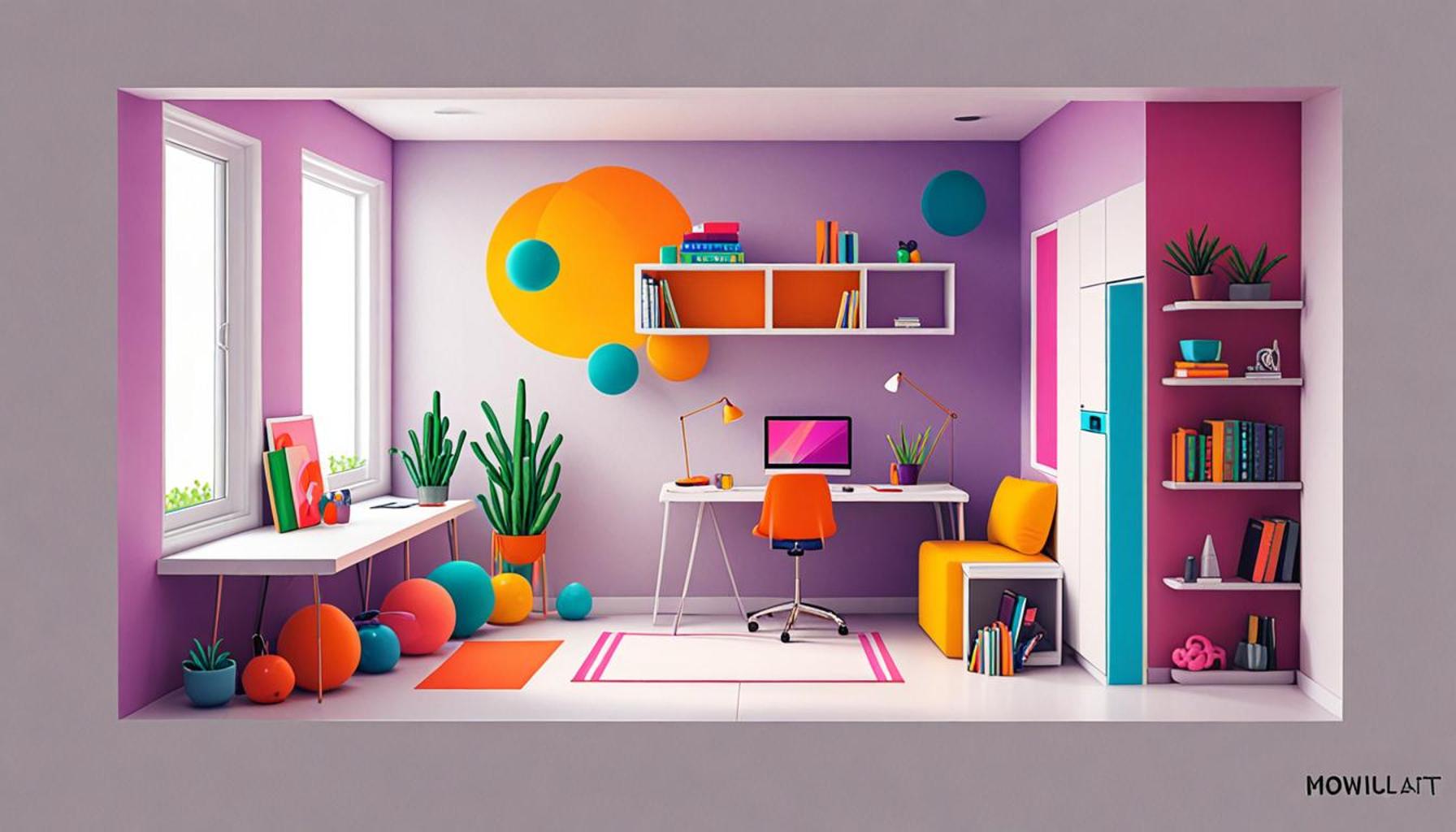How Minimalism Can Increase Space Efficiency in Small Environments

Unlocking the Potential of Small Spaces
In today’s fast-paced, urban lifestyle, maximizing limited space has become a necessity rather than a luxury. The concept of minimalism offers a powerful solution, allowing individuals to create a functional and aesthetically pleasing environment, even in the smallest of apartments or homes. Many urbanites, particularly in bustling cities like New York, San Francisco, or Chicago, face the challenge of designing an intimate living space that feels open yet cozy.
By adopting a minimalist lifestyle, you can:
- Reduce clutter: Fewer items mean a cleaner, more serene space. Emphasizing quality over quantity allows you to keep only those possessions that bring true value and joy to your life. For instance, consider investing in a few well-made furniture pieces instead of accumulating an assortment of lesser-quality items that serve no substantial purpose.
- Enhance functionality: Purposeful design choices lead to greater efficiency. Multi-functional furniture, such as a sofa bed or an extendable dining table, allows you to adapt your space easily for work, leisure, or entertaining. California’s trend for open-concept layouts showcases how effective reconfiguration can free up living areas.
- Utilize vertical space: Smart shelving and storage options expand usable areas. Wall-mounted shelves, tall bookcases, and under-bed storage can all help you make the most of your vertical dimensions. Balancing style and practicality, consider creating a gallery wall to display artwork or photos, which not only capitalizes on verticality but also adds a personal touch to your home.
This approach not only enhances the visual appeal but also improves the overall quality of life in confined environments. Research shows that cluttered spaces can increase stress and reduce focus, making the adoption of minimalism particularly beneficial. With urban living becoming increasingly prevalent in the United States, understanding how minimalism can transform small spaces is essential.
Embracing a minimalist lifestyle encourages you to focus on what truly matters. This philosophy can be applied not just to physical possessions but also to time management and social commitments, fostering a sense of tranquility amidst the chaos of city life. By prioritizing simplicity and intention, small environments can become havens of comfort and style, offering both utility and peace of mind.
As you explore the possibilities of minimalism, you may find inspiration through social media platforms like Instagram or Pinterest, where countless users share their own transformations of small spaces. By joining this movement, you’ll not only enhance your living conditions but also contribute to a growing community that values mindful living.
DISCOVER MORE: Click here to learn how to practice mindful consumption
Designing a Minimalist Space
Creating a minimalist living space involves thoughtful planning and deliberate choices that can lead to significant increases in space efficiency. The beauty of minimalism lies not just in its aesthetic appeal but in its capability to revolutionize how we interact with our environment. By stripping away excess and focusing on essentials, you can achieve a sense of openness and tranquility that may have previously felt out of reach in your small dwelling.
Prioritizing Essential Items is the first step toward establishing a minimalist approach. Begin by assessing your belongings and asking yourself a critical question: “Do I truly need this?” This examination enables you to retain only those items that serve a purpose or spark joy, effectively reducing your volume of possessions. Design experts recommend an item count; for example, only keeping three decorative pieces or five books in sight at a time. This not only minimizes clutter but also allows for individualized expression without overwhelming the visual space.
Moreover, embracing multifunctional furniture is pivotal in enhancing space efficiency. Stylish yet practical solutions such as storage ottomans, pull-out sofas, or nesting tables can transform your living area significantly. This type of furniture serves dual or even triple functions—providing seating, storage, and workspace, all in one. Particularly in urban apartments, where square footage is valuable, these versatile pieces become essential to making every inch count.
- Adaptive Living Spaces: Consider furniture that can be easily moved or reconfigured. An extendable dining table can accommodate guests on special occasions yet return to a compact size for everyday use.
- Vertical Solutions: Incorporate wall storage for books, plants, or decorative items. Floating shelves not only draw the eye upward—creating the illusion of higher ceilings—but also clear floor space.
- Under-utilized Areas: Make the most of spaces that often go unnoticed, such as the area beneath beds or couches. Utilize containers or bins to store items that are not frequently used but still necessary.
With a focus on design simplicity, small environments can appear larger and more inviting. A common misconception is that a minimalist environment feels cold or sterile; however, by thoughtfully integrating elements such as plants or textured fabrics, you can cultivate a warm and welcoming atmosphere. For instance, adding a few potted plants not only provides a pop of color but also contributes to improved air quality, creating a healthier living space.
Lastly, consider the role of natural light in maximizing your small space. Windows should remain unobstructed to invite light and create a sense of openness. Using sheer curtains or choosing a lighter color palette for walls and furnishings enhances this effect, making your home not just more functional but also more enjoyable to live in. This commitment to sustainability and light can encourage more intimate and harmonious living, which is at the core of the minimalist approach.
Understanding Minimalism in Small Spaces
In today’s world, where urban living spaces are shrinking, minimalism has emerged as a crucial design philosophy that enhances space efficiency. The essence of minimalism lies not just in aesthetics but in functionality, allowing individuals to create the illusion of more space without resorting to drastic measures like moving or renovation. The concept promotes the importance of selective belongings and emotional connection to items, which can transform how we perceive our living environments.
Key Advantages of Embracing Minimalism
Adopting a minimalistic approach can lead to several benefits. First, it results in decreased clutter, making it easier to navigate and maintain a tidy environment. This streamlined approach not only enhances physical space but also cultivates mental clarity and reduces stress. Second, using multifunctional furniture, such as a sofa bed or coffee tables with storage, optimizes space usage without compromising on comfort or style.
Practical Tips for Implementation
To effectively implement minimalism, begin by assessing your possessions. Identify items that add value to your life and consider donating or discarding those that do not serve a purpose. Next, invest in smart storage solutions like wall-mounted shelves or under-bed units that maximize space while minimizing visual clutter. Lastly, pay attention to your color palette; lighter colors can create a perception of openness and airiness in small rooms.
Table: The Benefits of Minimalism
| Category | Description |
|---|---|
| Clutter Reduction | A minimalist approach eliminates unnecessary items, providing more room to breathe. |
| Increased Functionality | Functional furniture allows for better use of available space, promoting a comfortable living area. |
| Mental Clarity | A less cluttered environment contributes to reduced stress and enhanced tranquility. |
| Aesthetic Appeal | Minimalist design provides a sleek, modern look, appealing to contemporary tastes. |
Incorporating these principles can significantly impact how small spaces can be utilized, making them feel more open and inviting. As you explore minimalist design, you will discover that space efficiency is not merely about having less but about making thoughtful choices that enhance your living experience.
DIVE DEEPER: Click here to learn about the power of conscious consumption
Streamlining Organization and Maintenance
Beyond the physical arrangement and design elements of a space, organization is crucial in achieving the profound benefits of minimalism. In small environments, maintaining order is not merely a luxury; it is a necessity. As possessions are whittled down to essentials, the organization becomes more intuitive, making it easier to keep the space clutter-free. A simple yet effective method is the one-in-one-out rule, which dictates that for every new item introduced to the space, an existing item must be discarded or donated. This practice not only curbs accumulation but also encourages mindful purchasing decisions.
Creative storage solutions play a significant role in enhancing space efficiency. Think beyond standard storage bins—how about utilizing the back of your doors for hanging organizers? Hooks and pegboards can transform previously wasted areas into functional storage solutions for items like accessories, kitchen utensils, or even tools in a home office. The increasing availability of customized modular shelving systems means homeowners can tailor their storage to suit their unique needs, thus optimizing the space available.
In addition to physical organization, digital decluttering can also amplify space efficiency. In our increasingly digital world, physical clutter often extends to our digital landscapes. Cleaning out digital files and emails not only reduces mental clutter but can also create a more streamlined, efficient work-from-home environment. Using cloud services for document storage instead of physical files can free up space and ensure that every square foot of your home serves a purpose. This strategy aligns perfectly with minimalism’s core principle: reducing excess.
Creating Zones within Small Spaces
Establishing distinct zones within a small area is another effective strategy for maximizing functionality while adhering to minimalism principles. By defining areas for cooking, working, and relaxing, you can enhance the flow of your space. This zoning can be achieved through cleverly positioned furniture, rugs, or even changes in paint color. For instance, a soft area rug can delineate a living area while still allowing for an open and airy feel across the entire space.
Moreover, using lightweight furniture that can be easily rearranged reinforces this idea of creating versatile zones. Having furniture on wheels can facilitate quick transformations for activities like entertaining guests or enjoying a quiet evening at home. With each piece of furniture serving a purpose, it is easier to maintain a minimalist lifestyle and keep your environment adaptable to your needs.
Incorporating Sustainable Practices
The principles of minimalism often align beautifully with sustainability. Choosing to invest in quality, long-lasting goods not only minimizes consumption and waste but also reduces the frequency of replacements, ultimately conserving space in both physical and mental contexts. For instance, opting for durable, multipurpose kitchenware or furniture crafted from sustainable materials can contribute significantly to an efficient and eco-friendly living space.
Minimalist living encourages individuals to evaluate their consumption habits and consider the environmental impact of their lifestyle choices. By focusing on essentials and sustainability, small spaces can become not just more functional, but also more harmonious and aligned with eco-conscious values.
DISCOVER MORE: Click here to enhance your productivity
Conclusion
In an era where the demand for urban living is ever-increasing, minimalism stands out as a transformative approach to enhancing space efficiency in small environments. By embracing the philosophy of fewer possessions and prioritizing essentials, individuals can not only create visually appealing and functional spaces but also improve their overall well-being. The strategies discussed—from streamlining organization through creative storage solutions to the deliberate creation of zones within a limited area—demonstrate how intentional design can lead to more adaptable and inviting homes.
Moreover, by integrating sustainable practices and mindful consumption, minimalism encourages a lifestyle that values quality over quantity. This shift not only reduces clutter but fosters an environment that emphasizes tranquility and clarity. As the trend of remote work persists, dismantling digital clutter further complements physical minimalism, merging productivity with an uncluttered mindset.
Ultimately, the beauty of minimalism lies in its versatility. Whether living in a compact studio apartment in New York City or a tiny house in the suburbs, the principles of minimalism can empower individuals to make the most of their spaces. By prioritizing functionality, aesthetics, and sustainability, small environments can flourish, becoming not just places to live, but sanctuaries that reflect personal values and lifestyles. Dive into the minimalist journey—your new efficiently organized, serene space awaits.


